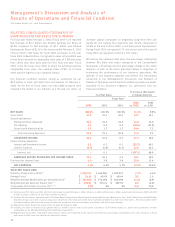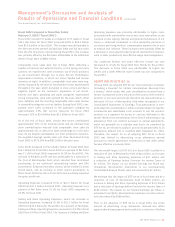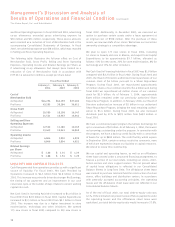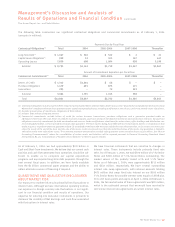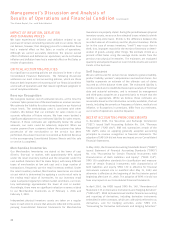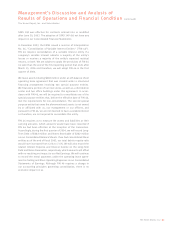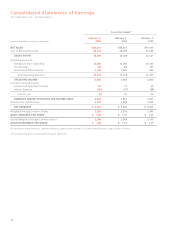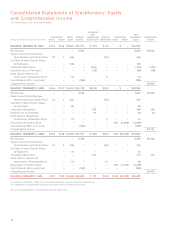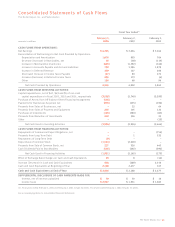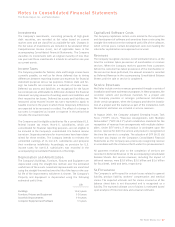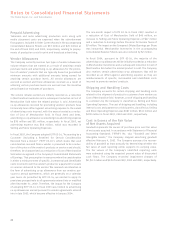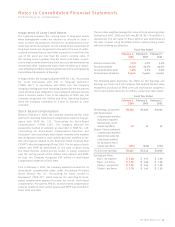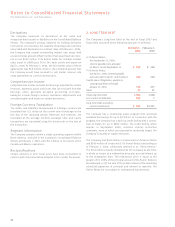Home Depot 2003 Annual Report Download - page 22
Download and view the complete annual report
Please find page 22 of the 2003 Home Depot annual report below. You can navigate through the pages in the report by either clicking on the pages listed below, or by using the keyword search tool below to find specific information within the annual report.IMPACT OF INFLATION, DEFLATION
AND CHANGING PRICES
We have experienced inflation and deflation related to our
purchase of certain commodity products sold in our stores. We do
not believe, however, that changing prices for commodities have
had a material effect on Net Sales or results of operations.
Although we cannot accurately determine the precise overall
effect of inflation and deflation on operations, we do not believe
inflation and deflation have had a material effect on Net Sales or
results of operations.
CRITICAL ACCOUNTING POLICIES
Our significant accounting policies are disclosed in Note 1of our
Consolidated Financial Statements. The following discussion
addresses our most critical accounting policies, which are those
that are both important to the portrayal of our financial condition
and results of operations and that require significant judgment or
use of complex estimates.
Revenue Recognition
We recognize revenue, net of estimated returns, at the time the
customer takes possession of the merchandise or receives services.
We estimate the liability for sales returns based on our historical
return levels. The methodology used is consistent with other
retailers. We believe that our estimate for sales returns is an
accurate reflection of future returns. We have never booked a
significant adjustment to our estimated liability for sales returns.
However, if these estimates are significantly below the actual
amounts, our sales could be adversely impacted. When we
receive payment from customers before the customer has taken
possession of the merchandise or the service has been
performed, the amount received is recorded as Deferred Revenue
in the accompanying Consolidated Balance Sheets until the sale
or service is completed.
Merchandise Inventories
Our Merchandise Inventories are stated at the lower of cost
(first-in, first-out) or market, with approximately 93% valued
under the retail inventory method and the remainder under the
cost method. Retailers like The Home Depot, with many different
types of merchandise at low unit cost and a large number of
transactions, frequently use the retail inventory method. Under
the retail inventory method, Merchandise Inventories are stated
at cost which is determined by applying a cost-to-retail ratio to
the ending retail value of inventories. As our inventory retail
value is adjusted regularly to reflect market conditions, our inven-
tory methodology approximates the lower of cost or market.
Accordingly, there were no significant valuation reserves related
to our Merchandise Inventories as of February 1, 2004 and
February 2, 2003.
Independent physical inventory counts are taken on a regular
basis in each store to ensure that amounts reflected in the accom-
panying Consolidated Financial Statements for Merchandise
Inventories are properly stated. During the period between physical
inventory counts, we accrue for estimated losses related to shrink
on a store-by-store basis. Shrink is the difference between the
recorded amount of inventory and the physical inventory. Shrink
(or in the case of excess inventory, “swell”) may occur due to
theft, loss, improper records for the receipt of inventory or deteri-
oration of goods, among other things. We estimate shrink as a
percent of Net Sales using the average shrink results from the
previous two physical inventories. The estimates are evaluated
quarterly and adjusted based on recent shrink results and current
trends in the business.
Self Insurance
We are self-insured for certain losses related to general liability,
product liability, workers’ compensation and medical claims. Our
liability represents an estimate of the ultimate cost of claims
incurred as of the balance sheet date. The estimated liability is
not discounted and is established based upon analysis of historical
data and actuarial estimates, and is reviewed by management
and third-party actuaries on a quarterly basis to ensure that the
liability is appropriate. While we believe these estimates are
reasonable based on the information currently available, if actual
trends, including the severity or frequency of claims, medical cost
inflation, or fluctuations in premiums, differ from our estimates,
our results of operations could be impacted.
RECENT ACCOUNTING PRONOUNCEMENTS
In December 2003, the Securities and Exchange Commission
(“SEC”) issued Staff Accounting Bulletin No. 104, “Revenue
Recognition” (“SAB 104”). SAB 104 summarizes certain of the
SEC staff’s views on applying generally accepted accounting
principles to revenue recognition in financial statements. The
adoption of SAB 104 did not have any impact on our Consolidated
Financial Statements.
In May 2003, the Financial Accounting Standards Board (“FASB”)
issued Statement of Financial Accounting Standards (“SFAS”)
No. 150, “Accounting for Certain Financial Instruments with
Characteristics of Both Liabilities and Equity” (“SFAS 150”).
SFAS 150 establishes standards for classification and measure-
ment of certain financial instruments with characteristics of
both liabilities and equity. SFAS 150 is effective for financial
instruments entered into or modified after May 31,2003 and
otherwise is effective at the beginning of the first interim period
beginning after June 15, 2003. The adoption of SFAS 150 did not
have any impact on our Consolidated Financial Statements.
In April 2003, the FASB issued SFAS No. 149, “Amendment of
Statement 133 on Derivative Instruments and Hedging Activities”
(“SFAS 149”). SFAS 149 amends and clarifies financial accounting
and reporting of derivatives, including derivative instruments
embedded in other contracts, which are collectively referred to as
derivatives, and for hedging activities under SFAS 133,
“Accounting for Derivative Instruments and Hedging Activities.”
Management’s Discussion and Analysis of
Results of Operations and Financial Condition (continued)
The Home Depot, Inc. and Subsidiaries
20






